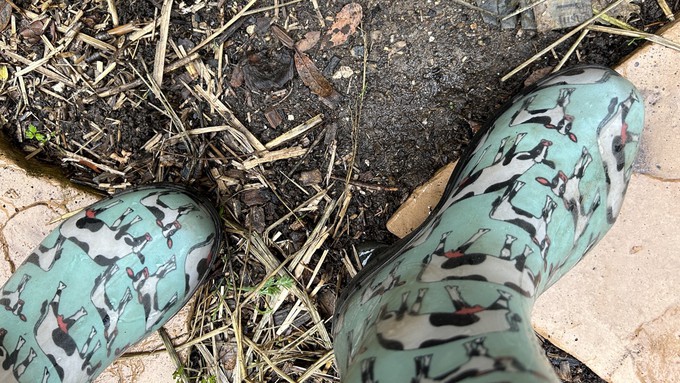
Celebrate and support the amazing structure underfoot

Protect wet soil by not stepping on it. (Stepping stones are especially useful in rainy weather.) And let it dry out a few days before digging in to plant anything. Kathy Morrison
The soil around Sacramento is pretty soggy today, a normal situation for December. We gardeners know not to walk on or dig in soggy soil, which can harm its important structure by destroying microbial relationships and pressing out the air. When it dries, clay soil without air basically is a brick – bad for the gardener, the plants and the soil’s health.
Tuesday, Dec. 5, marked World Soil Day, established to recognize and celebrate the amazing world under our feet. The theme for this year's observance, selected by the United Nations, was “Soil and water, a source of life.”
We can’t underestimate the importance of soil health. Parts of the world have soil that’s been so overworked, eroded or contaminated by heavy metals that it can’t support life, and that’s a tragedy.
So it’s appropriate to appreciate our soil every day. Here are ways to boost and maintain healthy soil at the garden and neighborhood level:
– Minimum tillage. That noisy rototiller is totally unnecessary to planting and harvesting healthy crops. Keep the hand tilling or “double digging” to a minimum, too.
– Crop rotation. Be aware of the plant families, and avoid planting members of the same family in the same spot year after year. Tomatoes, for example, should not be followed by peppers or eggplant, all members of the Solanaceae family. Try garlic (Amaryllidaceae) or spinach (Amaranthaceae) instead.
– Addition of organic matter. Compost, worm castings, aged animal manure, leaves and kelp meal are all appropriate soil amendments. And you don’t even have to dig them in: Spread them across the top of the soil and let the rain (like now!) or irrigation do the work to enhance the soil below it.
– Planting of cover crops. This isn’t called “green manure” for nothing. A cover crop – vetch, clover, bell beans or winter rye, for a few examples – planted now will grow over winter. It then can be cut down in February, raked into the soil and be broken down in time for planting summer vegetables.
Healthy soil also can enhance water infiltration and storage, did you know? The practices mentioned here contribute to carbon sequestration, too. So when we keep the soil healthy, we help the fight against water pollution and climate change. Our world's health starts with what’s underfoot.
Comments
0 comments have been posted.Sacramento Digs Gardening to your inbox.
Sites We Like
Garden Checklist for week of April 21
This week there’s plenty to keep gardeners busy. With no rain in the immediate forecast, remember to irrigate any new transplants.
* Weed, weed, weed! Get them before they flower and go to seed.
* April is the last chance to plant citrus trees such as dwarf orange, lemon and kumquat. These trees also look good in landscaping and provide fresh fruit in winter.
* Smell orange blossoms? Feed citrus trees with a low dose of balanced fertilizer (such as 10-10-10) during bloom to help set fruit. Keep an eye out for ants.
* Apply slow-release fertilizer to the lawn.
* Thoroughly clean debris from the bottom of outdoor ponds or fountains.
* Spring brings a flush of rapid growth, and that means your garden is really hungry. Feed shrubs and trees with a slow-release fertilizer. Or mulch with a 1-inch layer of compost.
* Azaleas and camellias looking a little yellow? If leaves are turning yellow between the veins, give them a boost with chelated iron.
* Trim dead flowers but not leaves from spring-flowering bulbs such as daffodils and tulips. Those leaves gather energy to create next year's flowers. Also, give the bulbs a fertilizer boost after bloom.
* Pinch chrysanthemums back to 12 inches for fall flowers. Cut old stems to the ground.
* Mulch around plants to conserve moisture and control weeds.
* From seed, plant beans, beets, cantaloupes, carrots, corn, cucumbers, melons, radishes and squash.
* Plant onion sets.
* In the flower garden, plant seeds for asters, cosmos, celosia, marigolds, salvia, sunflowers and zinnias.
* Transplant petunias, zinnias, geraniums and other summer bloomers.
* Plant perennials and dahlia tubers for summer bloom.
* Mid to late April is about the last chance to plant summer bulbs, such as gladiolus and tuberous begonias.
* Transplant lettuce seedlings. Choose varieties that mature quickly such as loose leaf.